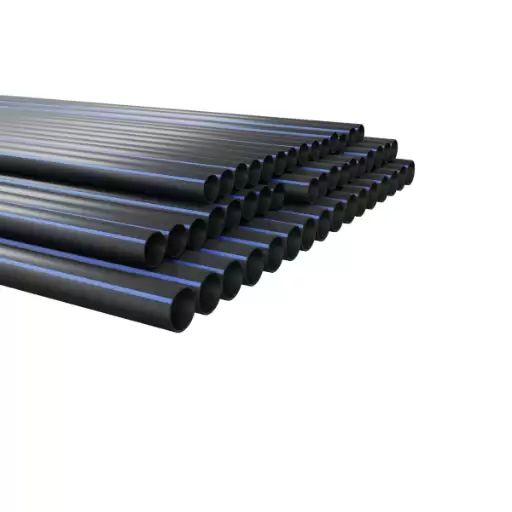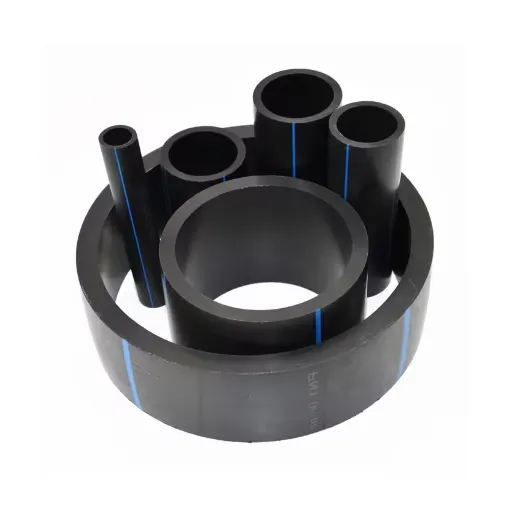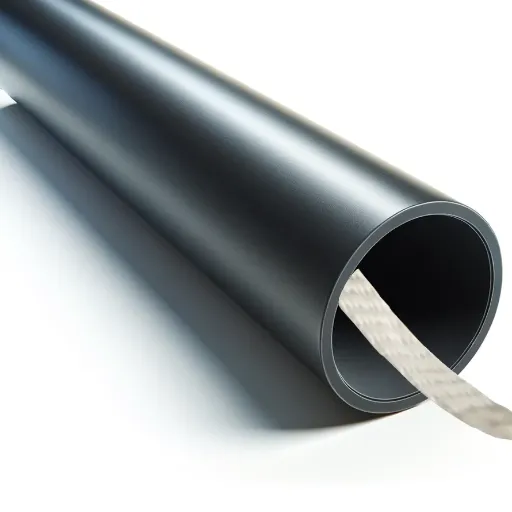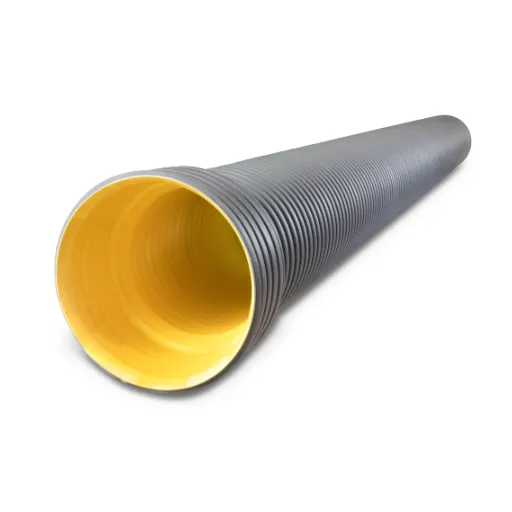High-density polyethylene (HDPE) pipes have become a critical component in modern infrastructure, offering unparalleled durability, flexibility, and reliability across various industries. Whether used in water distribution, gas pipelines, or industrial applications, understanding the pressure rating and size chart of HDPE pipes is essential for selecting the right materials for your project. This guide aims to demystify these technical aspects, ensuring you have the knowledge to make informed decisions.
What is an HDPE Pipe and How is it Used?

Understanding HDPE Pipe Material
HDPE (High-Density Polyethylene) is a type of thermoplastic polymer derived from petroleum. It is among the strongest materials used today because of its dense molecular make up. Furthermore, HDPE has superior strain resistances particularly, impact, abrasion and chemical which makes it perfect for extreme environments. Additionally, HDPE is designed not to fracture or shatter due to temperature or pressure changes, ensuring dependability and performance over prolonged periods.
Water transportation systems are a fundamental part of society and are one of the main uses of HDPE. Potable water distribution, irrigation, and storm sewer drains all make use of HDPE due to its structural strength and non-leak nature. On top of that, gas distribution networks also use HDPE pipes due to their flexibility and gas resistance, which greatly improves the overall safety and efficiency under elevated pressures.
Gas and water are not the only industries that make use of HDPE pipes, as they are widely used in other industrial sectors such as mining, chemical processing, and more advanced wastewater management. Their unique feature of being able to withstand high levels of corrosion with a variety of different materials, such as acids and slurries, makes them the perfect candidate for aggressive environments. Lower installation costs combined with longer service life make HDPE an appealing option for many industries.
Common Applications for Pipe Systems
Many industries rely heavily on piping systems, either to transport elements under specific conditions or to work with various factors. A few of the most widely accepted purposes include the distribution and transportation of water and gas, respectively, and even in dealing with industrial fluids. Piping made out of high-density polyethylene (HDPE) is particularly common because of its extreme reliability, adaptability, resistance to leaks, and stiffness in environmental conditions.
For water and gas pipelines, HDPE pipes are a preferred choice thanks to their flexibility, corrosion resistance, and ability to withstand both high and low temperatures without structural weakness. This allows them to utilize the supply systems of water in level municipalities, and even for the distribution of natural gas. Construction becomes easier with their lightweight nature, which cuts down on the time needed for setting up the piping systems.
HDPE pipes are important for industries that include mining and the servicing of chemical waste. The hydrocarbon processing industries heavily rely on these, on top of their usage in plumbing. Due to their long lifespan, these pipes can sustain dealing with abrasive materials, toxic chemicals, or dangerous levels of pressure, which makes them a very effective investment technologically and economically.
Why Choose Polyethylene Pipes?
Due to the durability, versatility, and cost-effectiveness of polyethylene pipes, they have become a premier option. Moreover, their resitance to corrosion inevitably surpasses traditional materials like steel or concrete, which guarantees long-term performance without degradation when exposed to harsh substances. This quality makes them ideal for applications dealing with water, chemicals, or other abrasives.
One of the main advantages of polyurethane poly pipes is their flexibility and lightweight structure. Their physical characteristics make them easy to transport, handle, and install, which contributes to the greater well-being as less time and labor are utilized. Furthermore, their ability to consume a great deal of stress and deformation without cracking ensures stability even in challenging environments such as ground movement and fluctuation range of temperature.
Moreover, polyethylene pipes provide users with adequate, sustainable, long-term cost savings. Their low maintenance requirements add significantly to reduced operational expenses, serving to reduce costs even further. Regardless of system type, whether municipal, industrial, or agricultural, these pipes deliver excellent performance without compromising environmental concerns as they are made from recyclable materials and energy-efficient techniques. The collaborative features serve to classify polyethylene pipes as a trustworthy and pragmatic solution for modern infrastructure needs.
How Does Pressure Rating Affect HDPE Pipe Performance?
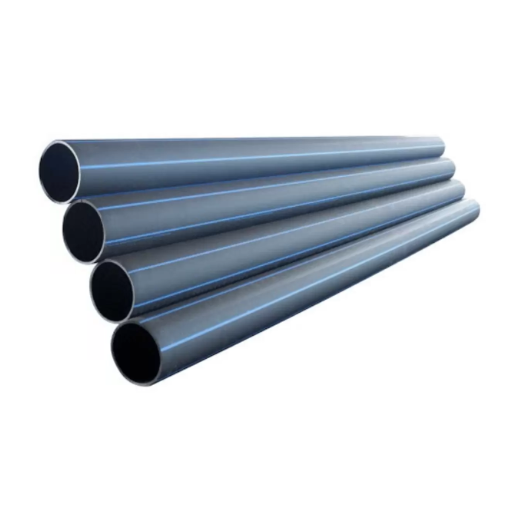
Defining Pressure Rating and Its Importance
In the context of pipes, pressure rating or maximum allowable working pressure (MAWP) is described as the limit of internal pressure the pipe can successfully withstand without damage. For high-density polyethylene (HDPE) pipes, this value is determined by a combination of factors, such as the strength of the material, the thickness of the walls, and the temperature of the system. This rating is crucial in confirming the operational efficiency and structural resilience of the pipes, particularly in a piping network with elevated pressure conditions.
An HDPE pipe that exceeds the pressure rating can experience internal ruptures, which can cause pipe wear down far sooner than expected, leading to catastrophic failure. The pipe is then forced into expensive repairs and system downtime. Selecting the wrong pressure rating also leads to further deformity possibilities, which result in unit elongation induced by continuous loads, leading to worse consequences.
On the contrary, opting for HDPE pipes with equal or higher pressure ratings than required offers a safety buffer while guaranteeing efficiency over the pipe’s service life. New developments in polymers have allowed the design of HDPE pipes with higher pressure ratings, which require particular grades for severe industrial pipelines or water distribution systems. This illustrates the need for compliance with prescribed pressure rating standards when designing and constructing piping systems.
Factors Affecting the Pressure Rating of an HDPE Pipe
The pressure rating when it comes to high-density polyethylene (HDPE) pipes is affected by some of the most critical factors and each of them influences the use of the pipes in particular applications.
- Material Grade and Classification: Different grades of polyethylene resin are used in the manufacturing of HDPE pipes which comes with an MRS classification. PE 63, PE 80, and PE 100 differ in molecular density and strength which affects pressure handling. For example, due to superior tensile strength and performance characteristics, PE 100 pipes out performs PE63 pipes in termsability to sustain higher pressures.
- SDR and Wall Thickness: SDR SDR is the ratio of the pipe’s outer Diameter and wall thickness. Lower SDR values will mean thicker walls and therefore higher pressure ratings, while higher SDR values indicate suitable low pressure applications due to decreased wall thickness.
- Effects of Temperature: HDPE pipes have a pressure rating that changes with temperature. Higher temperatures tend to lower the stiffness and strength of the material, thus reducing the pressure rating. For example, a 10 bar rated pipe at 20°C might lose a lot of its rating if it is operating at 60°C. Systems in thermally stressed environments require proper derating factors.
- Long Term Hydrostatic Strength (LTHS): LTHS is an important characteristic obtained from long-term testing. It describes the ability of a pipe to withstand sustained internal pressure over a sufficiently long period, usually 50 years. Because of having high LTHS, such pipes are more reliable for long term or heavy intensity use.
- Loads Externos and the Installation Environment: Pipes are impacted by external mechanical forces from soil pressure or traffic loads. Also, the soil must not cause too much stress. Stress control guarantees that the pressure rating is not reduced. Resistance to UV and other types of exposure, whether above ground or underground, also influences long-term usability.
- Creep Behavior: Creep is the distribution of HDPE’s viscoelastic properties, which tend to change shape over time when subjected to pressure. It is a design factor for calculating maximum pressure ratings for operations that involve continuous work.
These reasons reinforce the need for complete system designs which include material and environmental factors to guarantee the dependable and efficient utilization of HDPE pipes in different engineering applications. Knowledge of these factors improves the safety margin as well as the lifespan and efficiency of operations.
How to Interpret the HDPE Pipe Size Chart?
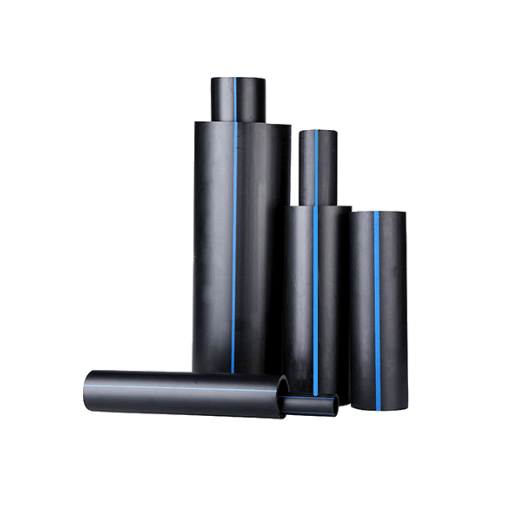
Understanding Nominal Pressure and PN Ratings
As with any component in pipeline engineering, a pipe’s ability to withstand the internal pressure during its operation is critically important, and must be measured against other procedures within the plant to avoid exceeding the safe limits. Determination of this value comes from environmental influences like wall thickness, material properties, operating temperature, and external loading conditions. For HDPE pipes, PN ratings typically are set between PN4 to PN25, with the higher rating yielding greater capacity for withstanding internal pressure.
PN ratings require strict observation of the Temperature Derating Factor. HDPE pipes are prone to temperature alterations, and their pressure resistance drops dramatically with increased heat. For example, within the scope of this PN rating, the pipe set to PN10 explosively drops performance to 6 bars once reaching operational temperatures of 45°C. Establishing the derating factor offered by manufacturers, along with the depleting value of the pipe’s PN rating, will yield the true permissible pressure required for concrete applications.
Surge pressure is secondary and emerges from abrupt flow velocity shifts within a pipe’s system, which can occur with pump start-ups and valve closings. Engineers and designers must keep in mind the damaging impact normatively high surge pressure can have in the pipe system where the threshold is not prone to exceed nominal value. In reality those values are offset for extended periods resulting in devastating structural joint weakening.
When selecting a pipe diameter, wall thickness, and PN rating for specific applications, the use of an HDPE pipe size chart is essential. Such charts usually feature Standard Dimension Ratios (SDR), which align with specific PN ratings. These aids guarantee compliance with engineering norms like ISO 4427 or ASTM D3035, streamlining efficiency throughout various shifts while meeting performance standards.
Choosing the Right HDPE Pipe Size for Your Project
One of the primary steps in choosing an HDPE pipe of a particular dimension size entails considering numerous factors that affect system efficiency, durability, and lifespan. The requirements of the system pressure must also align with the specified PN rating of the pipe to avoid overloading the equipment, causing undesirable results. In more advanced systems that need exact predefined flow rates, engineering simulations offer additional possibilities, or computational fluid dynamics (CFD) models can be used.
This decision also depends on the environment. For example, HDPE pipes used in high-temperature settings that never fail due to structural degradation from thermal expansion must have an appropriate temperature resistance class or derating factor. Also, soil constituents like acidity, alkalinity, or even abrasive particles must be evaluated for the need of additional protective coatings or layers that would prolong the life of the pipe.
Lastly, compliance with regulatory and industry standards like ASME B31.8 or DIN 8074 allows for the safe, quality, and operational performance of the installation.
What is the HDPE Pipe Classification System?
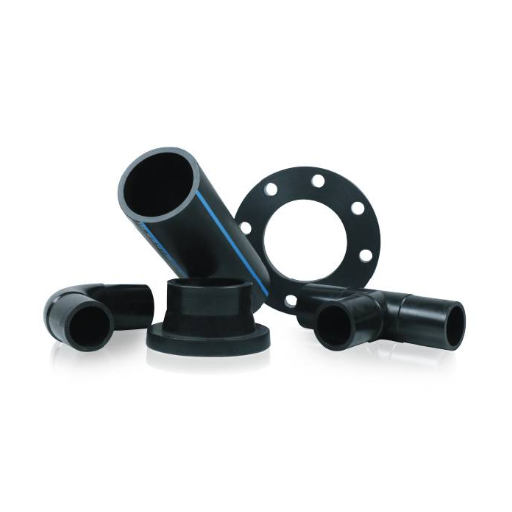
Exploring Different Types of HDPE
High-Density Polyethylene (HDPE) can be divided into different HDPE types based on its density, molecular structure, and even the performance traits of the material. These classifications serve an important purpose in assessing the applicability of HDPE materials across various industrial sectors. The principal forms of HDPE identified include PE47, PE63, PE80, and PE100, which are constructed by their minimum required strength (MRS) value measured in MPa. While all are important, the PE100 form is widely regarded as the one with the most advanced properties as it offers maximum strength, durability, and resistance to environmental stress cracking and impact.
A custom formulation is necessary to form each type of HDPE to fulfill specific operational requirements. Instead, for example, PE63 is commonly used in low-pressure water supply systems, precisely due to its moderate strength coupled with cost cost-effective nature. The same cannot be said with PE80, as that is mainly used in gas and even potable water pipelines with its resilient nature and safe grounds. PE100, on the other hand, is characterized by being highly resistant to pressure, chemicals, and temperature variances, making it eminently preferred for sewer systems, oil a gas pipelines, and even prominent mining applications. Besides these, the newly developed PE100-RC (Resistance to Crack) also improves performance considerably as it enhances the durability against slow crack growth under heavy loading.
A selection of predominant HDPE classification has an impact on system design while simultaneously affecting long-term cost. Knowing the differences among the HDPE classifications and picking one of the corresponding MRS Marked level engineering standards guarantees compliance with the technical specifications as well as ensures the maximum operational life of the component.
The Role of PN and PE 100/80 in Classification
The classifications of PN (Pressure Nominal) and PE (Polyethylene) are important in estimating the pressure capability and the HDPE pipe’s material grade. These classifications enable the proper selection of pipes for defined engineering tasks, guaranteeing safety and operational efficiency. Here is a table explaining the role of PN and PE 100/80 in the classification of HDPE pipes:
|
Classification |
Description |
Usage Application |
|---|---|---|
|
PN 6 |
For low-pressure systems up to 6 bar |
Irrigation systems, low-flow drainage |
|
PN 10 |
Medium-pressure systems up to 10 bar |
Water distribution, small industrial uses |
|
PN 16 |
High-pressure systems up to 16 bar |
Large-scale water supply, mining |
|
PE 100 |
High-density polyethylene with 10 MPa stress capacity |
Long-term durability in high-stress areas |
|
PE 80 |
Medium-density polyethylene with 8 MPa stress capacity |
Moderate environments, municipal piping |
Standardization of pipe selection is facilitated by this classification structure, which ensures compliance with design requirements and enables optimization of performance metrics. Proper compliance improves safety and reliability and enhances cost-effectiveness.
How HDPE Pipe Classification Impacts Industrial Applications
The way HDPE (High-Density Polyethylene) pipes are classified impacts their usefulness for applications in different industries. The industry provides a structured guideline on how to choose a piping solution by classifying them like PE 63, PE 80, and PE 100, which are based on strength and the material’s longevity under stress. With each grade providing unique benefits, PE 100 offers the most advanced features, including exceptional crack resistance, high pressure ratings, and durability in severe conditions such as mining, transmission of oil and gas, and large-scale irrigation systems.
As an example, PE 100 pipes have a higher molecular density, which not only increases the resistance to creep deformation under high pressures but also allows for the construction of thinner-walled pipes. This improves cost efficiency while also improving flow capacity. These advantages have intensified the use of PE 100 pipes in applications that need constant pressure reliability. Along with that, enhanced HDPE standards manufactured from resin have enabled the material to fulfill stringent environmental safety standards in potable water systems.
Proper classification of HDPE is vital to achieving project efficacy, cost effectiveness, and sustainability due to its reduced installation costs, energy-efficient production, and lifecycle performance. Precise engineering and installation practices further enhance the operational reliability of HDPE promising infrastructure built using modern industrial standards. This cements HDPE’s standing as an essential resource in contemporary frameworks.
How Does Quality Control Ensure Reliable HDPE Pipe Systems?
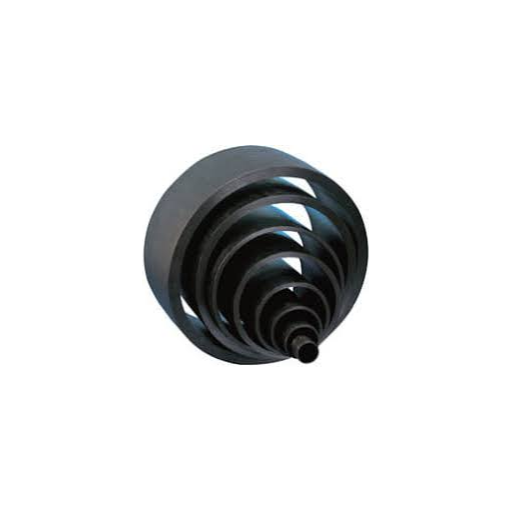
Testing Pressure Rating and Ability to Withstand Pressure
Controlling the pressure of HDPE pipe systems is one of the most crucial insights to revealing the system’s functionality under different conditions. Like the rest of the piping systems, pipes rated over a certain pressure undergo numerous tests concerning their performance over the expected life cycle. One of the major tests is Hydrostatic Pressure Testing (HPT), in which set pressures well above the rating are applied to see if the pipe can be deformed beyond recognition. HPT measures the maximum load the pipe can withstand without being permanently deformed.
The regression curve is one of the long-term pressure tests, and in combination with other long-period tests, is useful to extrapolate the behavior of the material for decades. It is done in tandem with determining the value of the lower limit of required strength (MRS) below which HDPE material’s certain level of strength falls. This allows further classification of the strength of the pipe, like PN16, PN10, and so on. The effect of temperature decline and operating conditions alongside the effect of constant applied load is also assessed to measure a realistic value for modeling the situation where the pipe system would be.
With introduction of up to date testing approaches alongside international standard compliance like ISO 4427 or ASTM D2837, reliability and performance of HDPE based pipe systems best able to handle operational conditions and demands for a given application such as allocated for water flow, industrial systems or sewage is validated.
Maintaining HDPE Pipe System Integrity
An integrity-maintaining protective approach on HDPE pipe systems based on best practices and inspections is necessary. Moreover, installation practices, including joint alignment and fusion procedures, must be properly performed as they affect long term performance. Sustained pressure within water distribution networks or industrial systems is known to fluctuate. Thus, regular pressure testing further confirms system stability.
The environmental influences require close monitoring. Inherently, HDPE materials resist many things, but UV radiation degrades material over time, necessitating additional aides like a protective outer layer. Furthermore, non-destructive evaluation by ultrasonic and hydrostatic testing reveal microstructural defects and stress points that could trigger critical failures.
Planned maintenance and adherence to set guidelines like ISO 13477 for slow crack growth resistance ensure consistent reliability of HDPE systems. As a result of the thorough approaches undertaken, operational disruption is minimal, confirming the resilience and cost efficiency of HDPE piping for essential infrastructure.
References
Frequently Asked Questions (FAQ)
Q: What is an HDPE pipe, and how does it differ from other types of pipes?
A: HDPE (High-Density Polyethylene) pipe is a type of plastic pipe used for fluid and gas transfer. It is known for its high strength-to-density ratio, flexibility, and resistance to corrosion and chemical reactions. Unlike PVC pipe or ductile iron pipe, HDPE pipe can be joined by butt fusion or electrofusion, providing leak-free connections that are ideal for high-pressure applications.
Q: How is the pressure rating of HDPE pipes determined?
A: The pressure rating of HDPE pipes is determined by the pipe’s material, wall thickness, and diameter. It is commonly expressed in terms of psi or pressure in bars. The pipe manufacturer provides this information, which is essential for selecting the appropriate pressure class for your specific needs to ensure the pipe can handle the expected load.
Q: What does PE4710 mean about HDPE pipes?
A: PE4710 is a designation for a specific type of HDPE material that offers high performance in terms of pressure and temperature resistance. It indicates that the pipe has a high density and is capable of handling higher pressure and temperature conditions, making it suitable for demanding applications.
Q: How do I choose the correct diameter HDPE pipes for my project?
A: Selecting the right diameter of HDPE pipes depends on factors such as the volume of fluid to be transported, the flow rate, and the pressure requirements. Consulting a comprehensive guide to HDPE pipe specifications and working with a knowledgeable pipe manufacturer can help ensure you choose the correct size for your application.
Q: What are the benefits of using HDPE pipe and fittings over other materials?
A: HDPE pipe and fittings offer several advantages, including flexibility, durability, and resistance to corrosion and chemical damage. They are lightweight, easy to install, and require fewer joints due to their long lengths, reducing the potential for leaks. HDPE pipes are also capable of withstanding the pressure and are available in various pressure classes to suit different applications.
Q: How does the thickness of an HDPE pipe affect its performance?
A: The thickness of an HDPE pipe, often referred to as its wall thickness, directly impacts its pressure rating and ability to withstand internal and external pressures. Thicker pipes can support higher operating pressures and are generally more durable, making them suitable for high-pressure applications.
Q: What are PN grades, and how do they relate to the pressure pipe?
A: PN grades, or Pressure Nominal grades, indicate the pressure in bars the pipe can support. They are used to classify pressure pipes based on their ability to withstand certain levels of internal pressure. Selecting a pipe with the correct PN grade is essential for ensuring the pipe can support the intended pressure with water or other fluids.
Q: What techniques are used for joining HDPE pipes?
A: HDPE pipes can be joined using several techniques, including butt fusion, electrofusion, and flange connections. Butt fusion involves welding the ends of the pipes together, creating a strong, seamless joint. Electrofusion uses special fittings with built-in electric heating elements to fuse the pipe ends. Flange connections are used for easy disassembly and reassembly.
Q: How do HDPE and PVC pipes compare in terms of durability and application?
A: Both HDPE and PVC pipes are durable and resistant to chemical and environmental factors, but they differ in flexibility and jointing methods. HDPE pipes are more flexible and can be joined using fusion techniques, making them suitable for a wider range of applications, especially where high pressure and temperature resistance are required.



